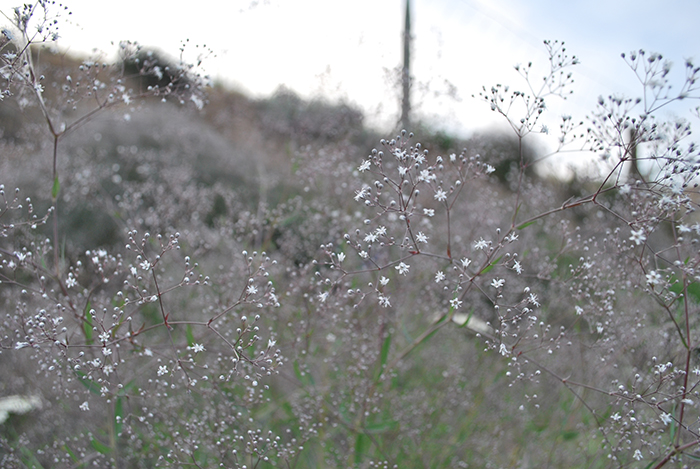
Baby’s breath, an invasive plant with small white flowers, colonizes dunes ecosystems along the Great Lakes and outcompetes native plants and animals. Image: Sarah Lamar
By Andrew Blok
Baby’s breath may sound like a bright spot in a long list of harmful invasive species, but the popular addition to floral bouquets threatens the Great Lakes’ iconic dunes.
That’s why researchers took a road trip to study its DNA. They hope to understand why baby’s breath thrives in unforgiving ecosystems around the Great Lakes and across the continent. That can help them learn how to better remove it from eastern Lake Michigan’s coastal dunes where it monopolizes the delicate ecosystem and outcompetes rare native species.
“Baby’s breath is patient zero for invasive effects,” said Shaun Howard, the protected lands project manager at The Nature Conservancy in Michigan.
The invasive plant has colonized Michigan’s dunes for decades, he said.
It crowds out native plants, releasing 13,000 seeds a year and extending taproots 10 feet into the sand. The seeds spread well on the windy dunes, while the long roots keep dunes from shifting naturally, said Sarah Lamar, one of the DNA researchers and a graduate student at Grand Valley State University’s Annis Water Resources Institute.
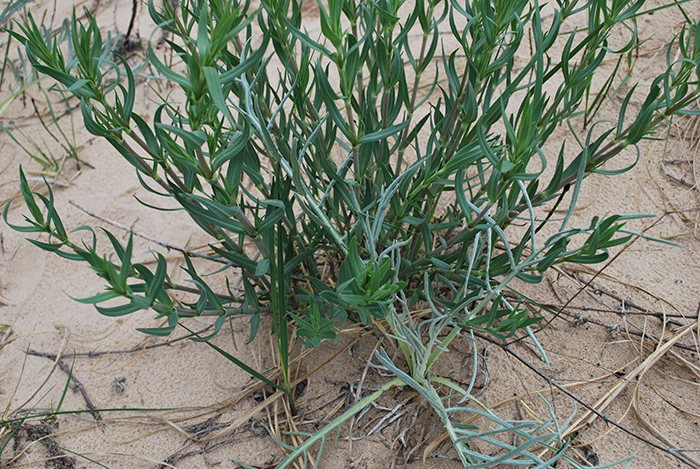
A young baby’s breath crowds a federally threatened Pitcher’s thistle. Baby’s breath can stabilize dunes ecosystems, which rely on disruption. Image: Sarah Lamar
A dune covered in baby’s breath is bad news for some threatened and endangered species that have evolved to survive in the volatile landscape.
“They can over stabilize the dunes,” Lamar said. “Dunes are a disturbance-driven ecosystem.”
The federally threatened Pitcher’s thistle fails to thrive near baby’s breath, though the reasons aren’t fully known, said Charlyn Partridge, another researcher and a professor at the Annis Water Resources Institute. It could be that blowing sand helps Pitcher’s thistle germinate or that baby’s breath better grabs nutrients from an ecosystem with few to spare. However it happens, baby’s breath is bad for Pitcher’s thistle.
It also replaces open sand and stone patches that endangered piping plovers require to nest. Howard knows of one location that hosted a new piping plover nest just a year after it was cleared of baby’s breath. When the dunes are restored to their original open state, they can host piping plovers once again.
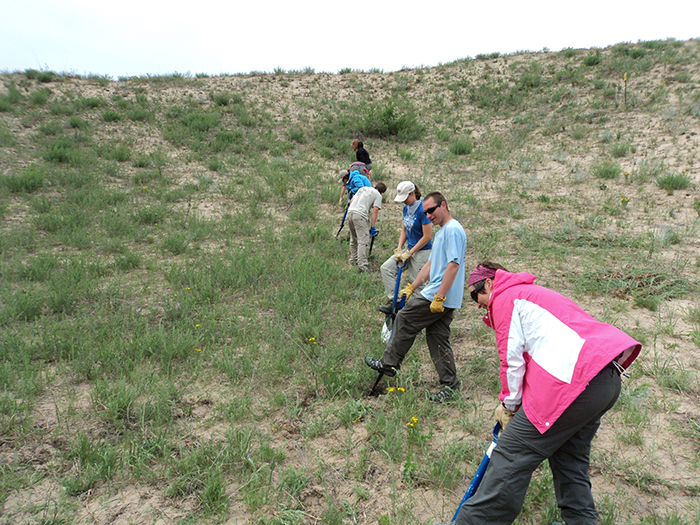
Severing baby’s breath taproot can kill it. If the cut is not made deep enough below the plant it can grow back. Image: Shaun Howard
Last June, Lamar and Partridge hit the road with a van full of lab equipment: “a million things that would have looked pretty sketchy if we’d been pulled over,” said Lamar, whose thesis focus is this research.
They collected samples of baby’s breath in North Dakota, Minnesota and Washington to map the genetic similarity of local populations across the west.
At each stop they collected and labeled 15 to 30 samples, marked them on a GPS system and packed them in silica beads to dry. Back at the institute’s lab they analyzed them for 14 genetic markers called microsatellites. These repetitive segments of DNA allow researchers to easily identify genetic mutations. Plants with fewer differences in their microsatellites are more closely related.
The analysis continues, but they’ve already found some interesting relationships.
Baby’s breath growing in Petoskey, Michigan, is more closely related to that in Washington state than that growing less than 100 miles away in Sleeping Bear Dunes.
That was a surprise. And a fortunate finding. Genetic diversity makes for healthier plants. And it told The Nature Conservancy to focus its eradication efforts on stopping the spread of the Petoskey and Sleeping Bear Dunes populations toward each other, Howard said.
If the populations merge, their offspring will be more genetically diverse and therefore healthier and harder to eradicate.
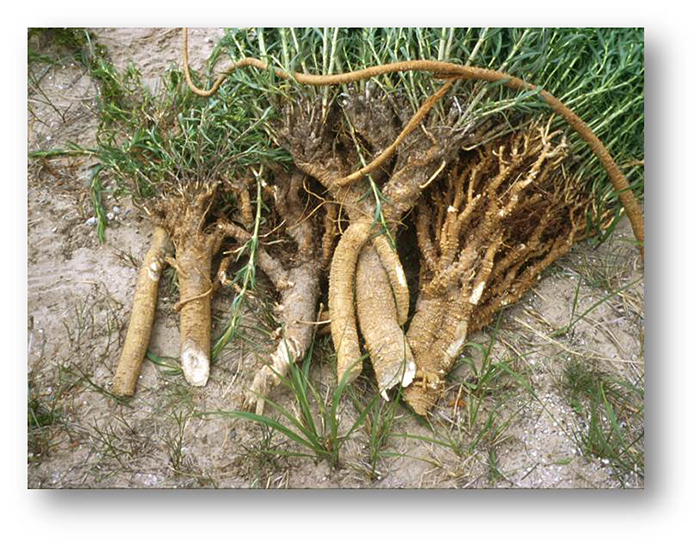
Baby’s breath taproots can reach 10 feet into the soil. These have been severed low enough to prevent them from sprouting again. Image: Shaun Howard
Findings like this also provide insight into the introduction and spread of the plant. It was commonly sold in seed catalogs as early as 1886, Partridge said. The team can confidently say there were multiple introductions, given the genetically distinct populations.
The team analyzed the RNA of another set of samples to identify how the plant’s genes are expressed.
Even if the Washington and Petoskey populations have similar genes, they use them differently to regulate the plant’s water use, flowering schedule and circadian rhythm, Lamar said.
This analysis tells researchers how plants respond to their environments. That can lead to more precise ways to kill them, Lamar said.
And any edge conservationists can get in the fight on baby’s breath is welcome.
“It’s very difficult to eradicate baby’s breath where it’s been established for decades,” Howard said.
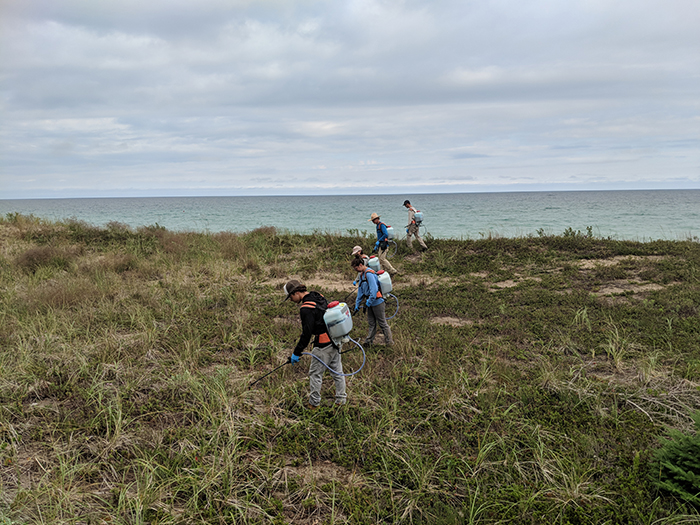
Spraying an herbicide is an effective way to control baby’s breath, though one some conservationists can be hesitant to use. Image: Shaun Howard
An herbicide is one way, although Howard doesn’t take that decision lightly since chemicals blown on the unpredictable dune wind can harm nearby native plants. Or, managers can sever the tap root below the soil so it won’t grow back. This is labor intensive and can disrupt nearby plants.
Despite the challenges, the efforts to control baby’s breath have been successful and conservation efforts are entering a maintenance mode.
In part, it’s because of research like that of Lamar and Partridge, which Howard lauds for its practical, applicable nature.
It feels really good to see progress, Howard said.
More is set to be made when baby’s breath management picks up again on the Lake Michigan dunes in May. As the DNA analysis continues, managers will be more knowledgeable and better equipped to reclaim more territory from this disruptive, stabilizing invasive.
This story was produced independently by Great Lakes Echo with financial support from the Cooperative Institute for Great Lakes Research.